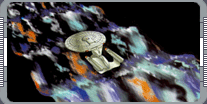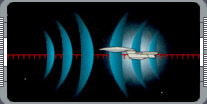
Soliton Wave
The soliton wave is a method of warp propulsion that could revolutionize the way spacecraft are
powered.
 Although still in its testing stages, the soliton wave may one day eliminate the need for bulky warp engines and
nacelles. Using the wave as a propulsion system takes away the onboard problems of maintaining the heavy fuel
and energy generating equipment needed to achieve warp speeds. An Impulse Propulsion System (IPS) would still
be required, but the size and energy specifications are much less significant. The theory behind the soliton
wave is to create a swell of subspace distortion that a ship can ride like a surfboard between points 'A' and
'B'. Although the soliton wave would require the two points - planets or planetoids - to be equipped with wave
generators and wave dispersal facilities, the energy and power efficiency benefits make it a worthwhile
proposition. The soliton wave provides warp speed without a warp drive.
Although still in its testing stages, the soliton wave may one day eliminate the need for bulky warp engines and
nacelles. Using the wave as a propulsion system takes away the onboard problems of maintaining the heavy fuel
and energy generating equipment needed to achieve warp speeds. An Impulse Propulsion System (IPS) would still
be required, but the size and energy specifications are much less significant. The theory behind the soliton
wave is to create a swell of subspace distortion that a ship can ride like a surfboard between points 'A' and
'B'. Although the soliton wave would require the two points - planets or planetoids - to be equipped with wave
generators and wave dispersal facilities, the energy and power efficiency benefits make it a worthwhile
proposition. The soliton wave provides warp speed without a warp drive.
To initiate the propulsion wave from point A on a planet's surface, field coils create the soliton wave and
direct it towards the coordinates of a waiting ship. The ship is then enveloped by the wave and rides it at
warp speeds to point B, which may be several light years away, where the energy of the wave is scattered by a
sister facility on the planet. The ship drops out of warp as the wave is dispersed. The leading developer of
the soliton wave is Dr. Ja'Dar, a scientist from Bilana III. Ja'Dar conducted key tests, with the help of the
USS Enterprise NCC-1701-D, in 2368, stardate 45376.3. The first
full test of the soliton wave provided much excitement for those involved; they historically compared it to the
breaking of the sound barrier by Chuck Yeager in 1947, and the light speed barrier by Zefram Cochrane in 2063.
During initial testing, the Enterprise was instructed to record telemetric data, while keeping 20 kilometers
away from the test ship because of the high levels of subspace interference generated by the wave. Once the
unmanned test was towed to a position two million kilometers from Bilana III, the test commenced and the field
generators were charged, sending the wave. This appeared as a bluish, rippling band of light that enveloped the
ship and successfully carried it to warp speeds. The Enterprise followed the wave and monitored all relevant
data.
 At first the wave was steady and stable, and the test ship's speed was recored at warp 2.3. There was two
percent energy loss between the wave and the ship, suggesting the system was over 450 percent more efficient
than the warp drive of a Galaxy-class starship. Following this,
however, the wave efficiency suddenly dropped to 73 percent, due to a power fluctuation. As the warp field
became unstable, severe subspace disruptions occurred. This effect expanded, and even caused damage to the
nearby Enterprise. The test ship dropped out of warp, and exploded due to severe shearing stress. It was
reported that a sudden drop in transfer efficiency occurred just before the explosion. The wave, however,
continued toward the terminus at planet Lemma II, but its power increased at an exponential rate. The scattering
field on Lemma II was not designed to cope with a wave this powerful, and the Enterprise was forced to fly
through the wave and head it off at the pass, firing a salvo of photon torpedoes to disrupt it. This dangerous
maneuver stopped the soliton wave and save many lives on the planet.
At first the wave was steady and stable, and the test ship's speed was recored at warp 2.3. There was two
percent energy loss between the wave and the ship, suggesting the system was over 450 percent more efficient
than the warp drive of a Galaxy-class starship. Following this,
however, the wave efficiency suddenly dropped to 73 percent, due to a power fluctuation. As the warp field
became unstable, severe subspace disruptions occurred. This effect expanded, and even caused damage to the
nearby Enterprise. The test ship dropped out of warp, and exploded due to severe shearing stress. It was
reported that a sudden drop in transfer efficiency occurred just before the explosion. The wave, however,
continued toward the terminus at planet Lemma II, but its power increased at an exponential rate. The scattering
field on Lemma II was not designed to cope with a wave this powerful, and the Enterprise was forced to fly
through the wave and head it off at the pass, firing a salvo of photon torpedoes to disrupt it. This dangerous
maneuver stopped the soliton wave and save many lives on the planet.
The initial tests on the soliton wave were therefore only partly successful, and its practicality remains
uncertain. Whether the soliton wave will ever replace warp drive on starships remains to be seen, although
early tests reveal some advantages to the wave. For now, Dr. Ja'Dar and the other scientists are at least left
to ponder the results of this test and work out how to make the procedure less dangerous.
|
|
"PROPULSION SYSTEMS" - JUNE 2000 ISSUE 14 STAR TREK: THE MAGAZINE COPYRIGHT OF PARAMOUNT PICTURES.
|